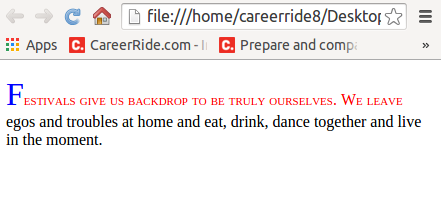<!DOCTYPE html>
<html>
<head>
<style>
img {
float: right;
}
</style>
</head>
<body>
<p><img src="http://www.careerride.com/image/thumb/Aug/2017/celebrating-festivals.jpg" alt="Ganesha" width="140" height="95"> Festivals give us backdrop to be truly ourselves. We leave egos and troubles at home and eat, drink, dance together and live in the moment. They are so intoxicating that all good memories keep us fresh for many days even after the fest day.<br>We can't imagine a life without festivals. While we enjoy our festivals, we learn how to be social, secular and enjoy every bit of life. They often help us with self exploration and personal growth that can be catalyst for many positive changes in life.</p>
</body>
</html>

<!DOCTYPE html>
<html>
<head>
<style>
p::first-letter {
color: #0000ff;
font-size: xx-large;
}
p::first-line {
color: #ff0000;
font-variant: small-caps;
}
</style>
</head>
<body>
<p>Festivals give us backdrop to be truly ourselves. We leave egos and troubles at home and eat, drink, dance together and live in the moment. </p>
</body>
</html>

<!DOCTYPE html>
<html>
<head>
<style>
img {
position: absolute;
left: 0px;
top: 0px;
z-index: -1;
}
</style>
</head>
<body>
<h1>Careerride.com</h1>
<img src="http://www.careerride.com/image/Oct/2017/albatross-can-fly-800-km-in-one-day.jpeg" width="250" height="250">
<p> Z index is used for specifying the overlapping element.</p>
</body>
</html>

<!DOCTYPE html>
<html>
<head>
<style>
div {
width: 250px;
height: 50px;
background-color: #FF00FF;
box-shadow: 10px 10px;
}
h1 {
color: white;
text-shadow: 1px 1px 2px black, 0 0 25px blue, 0 0 5px darkblue;
}
</style>
</head>
<body>
<div><h1>Careerride.com</h1></div>
</body>
</html>

<!DOCTYPE html>
<html>
<head>
<style>
p.class-selector {
background: yellow;
text-align: center;
color: blue;
font-size: 200%
}
#id-selector {
background-color: pink;
}
</style>
</head>
<body>
<p class="class-selector">This is an example of class selector.</p>
<p id="id-selector">This is an example of id selector.</p>
</body>
</html>
